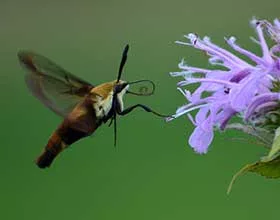 Mid-summer is prime time for our meadows and prairies. Butterflies are prominent among the insects visiting the yellow, pink, and purple flowers, drinking their nectar and distributing their pollen. But look carefully and you may spot the occasional moth among the butterflies. If that moth darts from flower to flower, more like a large bee or a hummingbird than a butterfly, you’ve probably found a clearwing!
Mid-summer is prime time for our meadows and prairies. Butterflies are prominent among the insects visiting the yellow, pink, and purple flowers, drinking their nectar and distributing their pollen. But look carefully and you may spot the occasional moth among the butterflies. If that moth darts from flower to flower, more like a large bee or a hummingbird than a butterfly, you’ve probably found a clearwing!
What is this animal?
The snowberry clearwing moth, Hemaris diffinis, is one of two species of clearwing moths in Ohio; the other, Hemaris thysbe, is the hummingbird clearwing. Clearwings are day-flying moths in the family Sphingidae, the sphinx moths. Most sphinx moths are nocturnal, and so usually they are encountered when they come in to lights at night. Perhaps the most familiar representative of the family is the tomato hornworm, a sphinx moth caterpillar that feeds voraciously on tomato leaves.
Why is it furry?
The “fur” on snowberry clearwings—actually modified scales made of chitin, not hair made of keratin—serves two functions. The first relates to body temperature regulation. Unlike most insects, sphinx moths are endothermic, meaning that they maintain a warm body temperature using heat generated internally from muscle contractions. Sphinx moths actually achieve body temperatures much like our own, and they can’t fly until they warm up. (You can see them shiver when they are preparing for flight.) The insulating fur on their bodies helps these moths to retain heat rather than lose it to the environment.
The second function of the furry body is to create a disguise. Snowberry clearwings also are known as bumblebee moths, and they are thought to gain protection from predators by mimicking bumblebees. Their coloration and furriness, along with behavior, are keys to that mimicry.
Aren’t moths nocturnal?
Indeed, the great majority of moths, including sphinx moths, are nocturnal. But exceptions occur among many groups of moths. In sphinx moths, genetic comparisons between day- and night-active species suggest that those groups evolutionarily diverged nearly 30 million years ago. Day-flying may have been an evolutionary response to the diversification of nocturnal predators (bats), which occurred around that same time.
Why is it visiting that flower?
The mouthparts of moths and butterflies are specialized for feeding on liquids. For most species, that liquid is flower nectar, though some species feed on sap, rotting fruits, and other juices, and many occasionally drink water. Hemaris diffinis moths feed from a variety of flowers, but locally they seem to favor bee balm (also called wild bergamot; the flower in the photo) when it’s available.
Nectar is pretty much just sugar water, though the concentration and specific identity of nectar sugars—e.g., glucose vs. sucrose–vary from plant to plant. Nectar contains just traces of other nutrients like amino acids (the building blocks of proteins) and minerals. How do these moths get by on such a nutrient-poor diet? In fact, adult moths don’t live very long and they aren’t growing. The females do lay eggs, but the nutrients to support that activity are accumulated by the caterpillar and retained through metamorphosis to the adult. Many adult moths even have reduced mouthparts and don’t eat at all. But for those that do—like clearwings–the diet just needs to provide energy for flight so they can find a mate. Sugar water (nectar) is perfectly adequate!
How does the moth stay in place to drink nectar?
Like hummingbirds, clearwing moths hover in front of flowers while they feed. To do that, they beat their wings even a little faster than hummingbirds, about 75 flaps per second! Their shallow figure-eight pattern of wing movement generates the lift that supports hovering. Unlike hummingbirds, clearwings further stabilize their feeding position by lightly touching their front two feet on the flower. It’s hard to see in real-time, but very clear in photos.
What’s up with that tongue?
Moths feed on liquids, and so the tongue (more properly, the proboscis) functions much like a straw. The proboscis is constructed from two long, crescent-shaped halves that adhere together, forming a tube with a hollow center. When not in use, the proboscis is flattened and coiled up tight, like an empty fire hose. To extend the tongue for feeding, muscles in the head squeeze insect body fluid (hemolymph) through a valve into hollow chambers of the proboscis wall; the fluid pressure straightens out the coil. After feeding, another muscle opens the valve, and tiny muscles inside the proboscis, along with natural elasticity, restore the coiled configuration.
Drinking relies on a combination of mechanisms. Initial fluid uptake apparently occurs by capillary action, drawing liquid through the open tip of the tongue and narrow slits in its sides. Then, muscles in the head activate a pump, expanding a chamber to create suction pressure that moves the liquid up the proboscis and into the digestive system.
The effectiveness of the moth proboscis depends on its length and diameter, along with the viscosity (sugar concentration) of the nectar—sort of like trying to drink a milkshake through a straw. Over the millennia, those properties of moths and flowers have evolved together. Clearwing moths have tongues nearly as long as their body, which they use to reach nectar deep within the bergamot flowers. The longest known moth tongue actually belongs to another sphinx moth, one that feeds from orchids in Madagascar and has a tongue that’s 25 – 30 cm (10+ inches) long! In each case: the moth gets its nectar and, in the process, the flowers are pollinated.
Article and photo contributed by Dr. David L. Goldstein, Emeritus Professor, Department of Biological Sciences, Wright State University.
